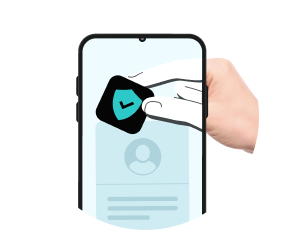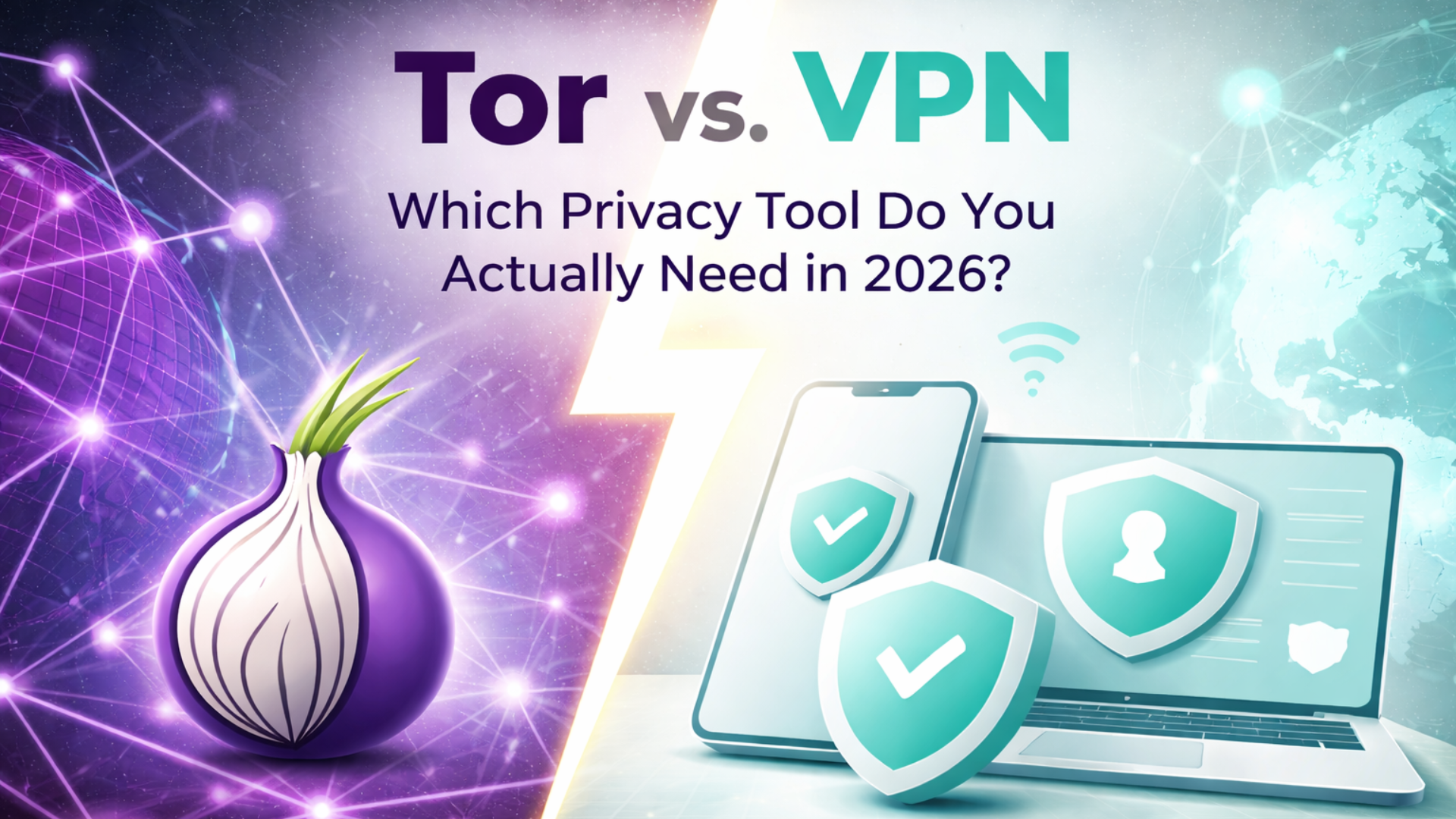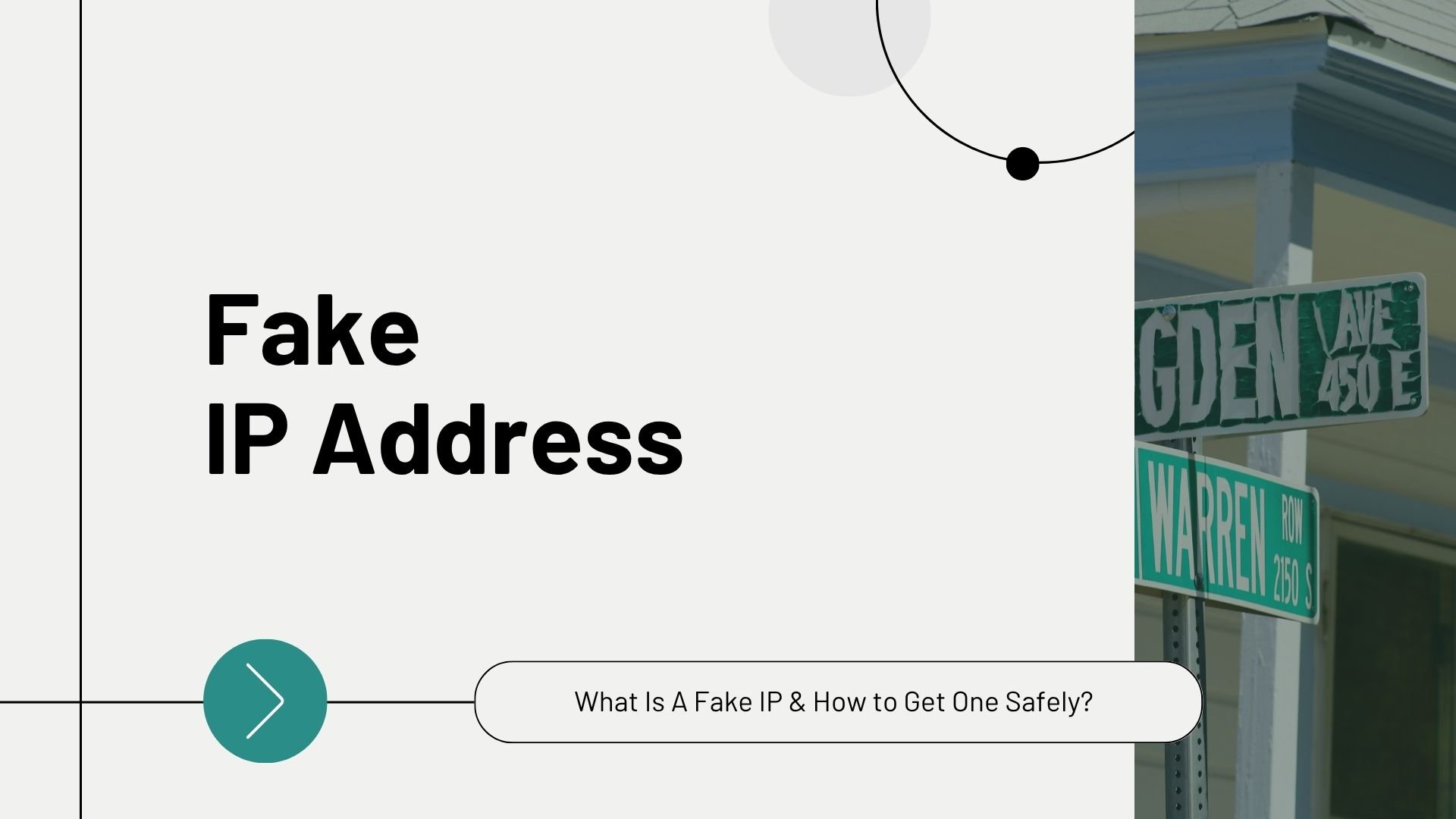
Your IP address provides your device with a unique identity online and facilitates a network connection. However, it also comes with limitations and risks. Your approximate location could be exposed, and your Internet Service Provider can always know what you are doing online. With a fake IP, however, worries disappear. Check what it is and how to fake an IP address safely here.
Disclaimer: Use a VPN to fake your IP address for legal purposes only. We do not condone illegal activities. Please always comply with all applicable laws.
Table of Contents
What Is A Fake IP?
Before discussing fake IPs, let’s first figure out what an IP address is. An IP address stands for Internet Protocol Address, and is a unique digital identifier assigned to your device by your Internet Service Provider. An IP address plays a vital role in facilitating network connections, but it also comes with risks of being monitored or tracked.
In contrast, a fake IP address is an IP address given by certain IP service providers to help mask your real IP and location online. Certain methods to fake an IP address, like using a VPN, can even help encrypt your internet connection, further enhancing your overall online privacy and security.
5 Common Ways to Get Fake IP Addresses
Here are 5 commonly used methods to get a fake IP address. They work differently and are designed for different purposes.
1. Random IP Generator
When searching for “fake IP” on the web, you’ll see many random IP generators ranked on the top pages. This type of fake IP generator uses algorithms to create fake IP addresses following the real IP formats. Tons of random numerical sequences like 192.168.23.154 can be easily generated within seconds.
However, this type of fake IP address generator only creates valid but non-functional solutions. These created IPs play a role more like giving examples or for testing uses, and can not be manually configured for your network to interact with the real internet.
How to Generate Random Fake IPs?
Most of the random IP generators can be operated directly on the browser and require no installation. Take IPVoid as an example.
Step 1. Visit “ipvoid.com/random-ip” or any other tool you prefer.
Step 2. Customize whether IPv4 or IPv6 address you want, and enter the amount you need.
Step 3. Click “Generate” to create random IP sequences
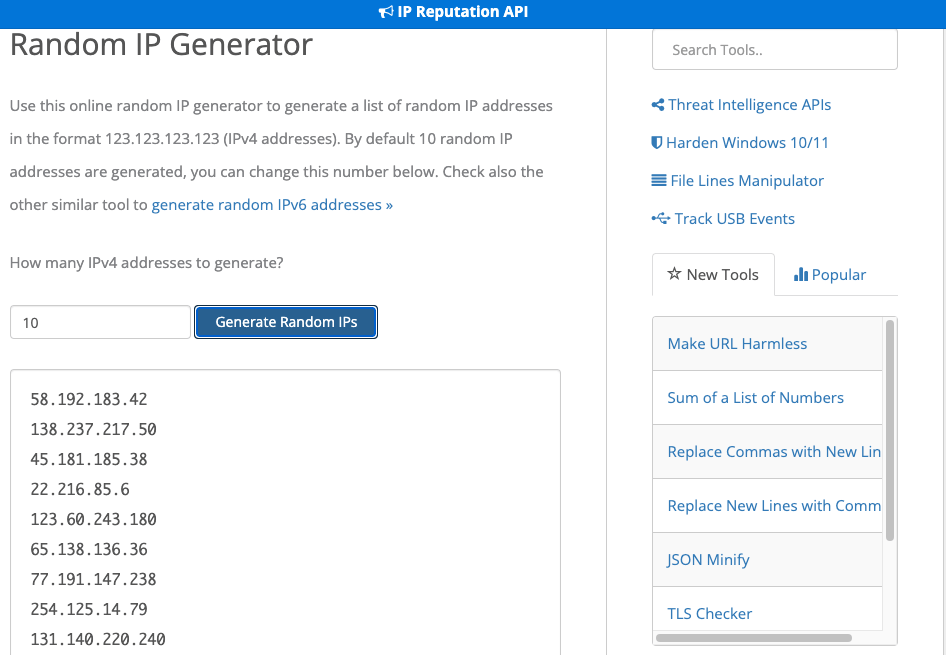
Pros & Cons
| Pros | Cons |
| Completely free | Not functional IPs |
| Super fast generation | No real-IP protection |
| No installation required | Can’t control the IP location |
| Generate vast fake IPs |
Best For:
IP newbies need an example, or developers need dummy data for software testing.
Can you fake an IP address that actually works? Yes, the following 4 methods can fake your IP address to communicate with the real internet.
2. VPN
A VPN fakes your IP address by routing your traffic through its VPN server. Acts on your behalf, this server communicates with the internet using its own IP address instead of yours, thus keeping your real IP safely hidden.
Among all 5 IP faking methods, VPN offers the highest level of security. Once connected, an encrypted tunnel between your device and the server is built. All the data transmitted stays protected from trackers, snoopers, hackers, and other threats.
Crucially, VPNs give you control over your fake IP location. Unlike methods offering random IPs, a professional VPN service provides a vast global server network. For example, X-VPN offers 8,000+ server locations around the world, you can fake your IP address to anywhere at a precise city level. Additionally, when you need a consistent fake IP for specific tasks, X-VPN covers it with its static IP feature. You can always connect to the same IP and stay consistent online.
How to Fake IP Address with a VPN?
The steps to get a fake IP with VPN are easy to follow. Taking X-VPN as an example, you can either get a random IP address with the free version or upgrade to premium for the free selection from 8,000+ server locations.
Step 1. Download X-VPN and log in with your premium account.
Step 2. Navigate to “All Locations” and select a VPN server to connect.

Step 3. You can check your current IP with services like “whatismyipaddress.com” to see whether the VPN works.
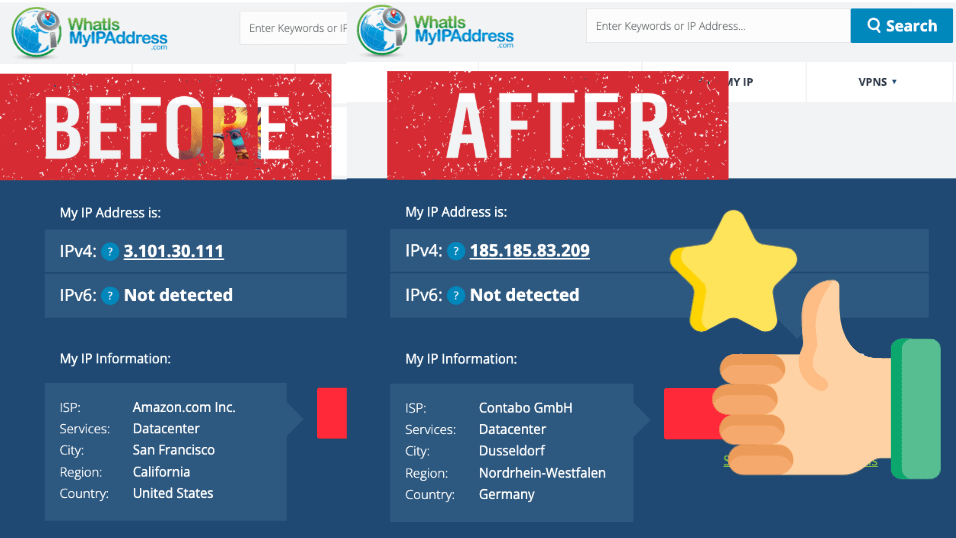
Pros & Cons:
| Pros | Cons |
| Enhanced privacy | Potential speed drops |
| Top level of security | Subscription costs |
| Location control | |
| Static IP feature | |
| Easy to use |
Best For:
Faking IP with a VPN works perfectly for people who want to enhance privacy, access global content, stay secure online, and more.
3. Proxy Server
A proxy server fakes your IP address by acting as a middleman for your browser that forwards your web traffic through its own IP address. Different than the VPN options, proxies often operate at the browser level instead of the entire operating system.
Also, proxy servers do not encrypt your data as a VPN does. Your ISP, public Wi-Fi owner, or online hackers can still monitor your activities. Besides, most proxies randomly assign you a fake IP, and own a smaller IP pool than VPNs. For example, X-VPN provides 8,000+ VPN servers and allows you to choose cities, while a proxy service like hidemy.name provides a random city connection within its 60+ country options.
How to Fake an IP Address with a Proxy?
Step 1. Visit a free proxy site, for example, “croxyproxy.com”.
Step 2. Enter a website you want to visit through a fake IP address, or search for content you want.

Step 3. You can also verify the IP change at whatismyipaddress.com.
Pros & Cons:
| Pros | Cons |
| Faster than VPNs for no encryption | Usually ads-supported |
| Fake IP online, no downloading | No traffic encryption |
| Most services are free | Less location control |
| Unstable connections |
Best For:
People who need only a quick IP masking for basic web browsing without security concerns.
4. Tor Browser
The Tor Browser can also fake your IP address through multiple layers of “nodes.” Your data goes like Belgium → Australia → Brazil (…), from at least 3 nodes to unlimited, your online traffic is well encrypted between them, and the destination of your browsing can only see the IP address of your final exit node.
Faking an IP address with this method is extremely secure, with some sacrifice on speed, however. The nature of multi-encryption is tested to lose about 50-80% of internet speed. Also, you cannot choose specific IP locations as your exit node, and it changes per session, making static IPs impossible.
How to Fake IP with Tor Browser?
Step 1. Download Tor Browser from the official site “torproject.org/download”.
Step 2. Launch the app and click “Connect” without any further configuration steps.

Step 3. Enjoy top anonymity browsing without worrying about real IP exposure.
Pros & Cons:
| Pros | Cons |
| Free and easy to use | Extremely slow speeds |
| Maximum anonymity | Some websites are blocked here |
| No tracking or cookies | Can’t select a fake IP location |
Best For:
People who work with sensitive data and require extreme anonymity instead of speed.
5. Public Wi-Fi
The last method to get a fake IP instead of your real one is to connect to a public Wi-Fi network. In this way, your device will be assigned a private IP by the Wi-Fi router, and all your internet traffic goes out and in with the Wi-Fi network’s public IP address.
Though the public Wi-Fi’s public IP replaces your own real IP addresses, it offers zero security or privacy. Your traffic is unencrypted and exposed to hackers. Can the WiFi owner see what you are doing online? Yes, and the situation is getting worse if it is offered for a malicious purpose. Also, there’s no location control, the “fake” IP you get is just within the hotspot’s physical area, except if the router is VPN configured.
How to “Fake” IP via Public Wi-Fi Connection?
Step 1. Connect to any open Wi-Fi, which can be generally found at a café or airport.
Step 2. The network automatically assigns a new IP for you.
Step 3. Browse with the Wi-Fi’s public IP address.
Pros & Cons:
| Pros | Cons |
| Easy to get | Can only fake within a limited area |
| Free to use | Highly dangerous |
| Zero data encryption | |
| No location choice |
Best For:
Actually, it’s best for no one. The risk of connecting to a random public Wi-Fi outweighs using your real IP.
Why You Need A Fake IP Address?
When talking about “fake”, people often associate it with deceptiveness and bad things, but actually, faked IP addresses can be used legitimately and bring valuable benefits.
Easy Testing
Remove IP Bans
Enhance Online Privacy
Access Domestic Content Abroad
Conclusion
The creation of IP addresses greatly convenience our digital life, but also gives man man-in-the-middle path to track. A fake IP can perfectly solve this by replacing the real one with the service providers’. Among the 5 methods to fake an IP address, using X-VPN is tested to be the safest, most flexible and most location-controlled way out. Get it now!
FAQs
Fake IP vs. IP Spoofing
Are fake IPs and IP spoofing the same? No, they differ in method, purpose, and legality. Fake IP refers to using someone else’s IP address to enhance privacy, which is usually legal. In contrast, IP spoofing uses techniques to conduct malicious activities such as DDoS attacks and is usually involved in illegal activities.
Can You Fake An IP Address?
Yes, you can easily fake an IP address with VPNs, proxies, Tor browser, or a public Wi-Fi connection. They’ll change your IP address online and improve your digital privacy.
Is It Legit to Fake An IP Address?
Faking an IP address is legitimate in itself, but how you use it can result in different legal consequences. Using a fake IP for testing, privacy protection, and to regain certain access rights can be legal. But conducting fraud, piracy, and other malicious activity will violate certain laws.
Is It Safe to Fake An IP Address?
Faking an IP address is safe only when you choose the right method. Doing it with a trusted VPN, Tor browser, and a reliable proxy is generally considered safe. But faking it through public Wi-Fi, or mischoosing untrusted tools, may lead to IP leaks, data breaches, and even identity theft.

